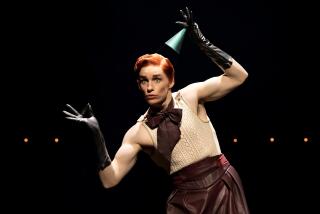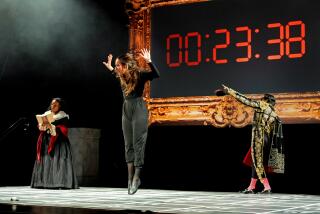This Dido lives and dies a dancer
In 1988, Mark Morris was invited to make his dance company a resident ensemble at the Théâtre Royal de la Monnaie. As part of Brussels’ opera company, he was told to think as big as he liked. He did, and that was, for him, a new opportunity. During his three years in Belgium, he also thought differently, which was not so new for him but produced newly outrageous results when combined with thinking big in Old World operatic Europe.
FOR THE RECORD:
‘Dido and Aeneas’: A review in the April 24 Calendar section of the opera “Dido and Aeneas” at the Irvine Barclay Theatre identified the baritone who sang Aeneas as Charles Johnstone. He is Christopher Johnstone. —
In 1989, he made a version a Purcell’s “Dido and Aeneas.” He placed the singers and chorus in the pit and choreographed the 55-minute opera as a dance work for himself as both the Carthaginian queen, Dido, and her nemesis, the Sorceress.
The work was self-indulgent, what with big-boned, long-haired Morris lacking feminine grace and emoting like crazy to Purcell’s refined music. A British Baroque composer, Purcell wasn’t entirely sexless in his music, but he was more than a little understated in highly formalized Elizabethan music.
Morris’ sexuality, on the other hand, was a tangle of transvestite taboos. Onstage, he was dangerously beguiling while at the same time functioning as a brilliantly musical choreographer busily breaking other taboos in his mixture of camp and high art.
Now “Dido” is back. The Mark Morris Dance Group began a six-day run of Purcell’s opera Tuesday night at the Irvine Barclay Theatre. Morris no longer dances in the production, but he has found a new role for himself. This time he conducts! Bradon McDonald took on Dido and the Sorceress on Tuesday, and he will alternate with Amber Darragh. One day Craig Biesecker (Aeneas) has a male partner, the next a female.
McDonald is an exquisite dancer and physically unlike Morris. Gender is still an issue, but the sheer grace of McDonald’s movements makes him less startling. Morris’ conducting had something to do with this as well. His pit experience is limited. “Dido” is the second score he’s conducted (he led Vivaldi’s “Gloria” once in New York). Mostly he’s worked with musicians from Emmanuel Music, the company in Boston with which he has long collaborated, and they provide a comfort zone.
Tuesday, though, he led members of the Pacific Symphony, along with his own players for the continuo parts (cello, lute and harpsichord). He didn’t get off to a particularly good start -- neither string intonation nor his slow tempos felt secure. I can’t report on his stick technique (he was buried in the pit), but his performance was cautious. Rhythms lacked snap. Still, he was competent and never seemed to be competing with the dance.
This made sense, because in a certain sense Morris’ choreography conducts the score. The dancers’ gestures are so music-specific that I wonder whether all wouldn’t be just fine if the musicians and singers were put onstage and simply followed the dancers.
Purcell’s opera takes a roundabout approach to the story of Aeneas, who on his way to found Rome after the Trojan War stops off in Carthage, where he falls in love with Dido but is forced by the gods to break off the romance and get on with his mission. Most of the opera unfolds from Dido’s point of view. Purcell’s librettist, Nahum Tate, added some scheming witches, which were popular in Elizabethan times. Dido dies of sorrow.
The music is highly structured, and Morris respects that deep structure while continually playing with the surface, where his dancers’ movements can be formalized or goofy. But, whether high or low, the gestures always work. Maile Okamura, who danced Dido’s sister Belinda, brightly wiggled her fingers the way the Russian conductor Valery Gergiev wiggles his fingers when conducting opera. I was perfectly willing to believe she was producing the sound from the strings as well as from her vocally lithe alter ego, soprano Yulia Van Doren, in the pit.
McDonald and Jaime Van Eyck, who sang both Dido and the Sorceress, merged hauntingly -- if weirdly. On one level, the dancer was like a great silent film actor (actress?) in a fourth dimension. He had a voice, just not his voice and just not in his body or of his sex. But it still felt as if the sound was coming from within him. Biesecker’s athletic, agile Aeneas seemed tenor-like to me. This created an interesting disconnect between him and baritone Charles Johnstone, who was singing the role, but it was an excellent way to express the character’s duplicity.
There are hundreds of ingenious touches in translations of music to movement in this “Dido.” The set, a lovely cloth backdrop and a few benches designed by Robert Bordo, all carefully lighted by James F. Ingalls, stays out of the way. But Morris is a master of diversion, and Tuesday’s performance offered many marvelous moments of that, such as the diminutive Lauren Grant’s humorously macho impersonation of a sailor.
Diversion, though, turns out to be, like his early outrageousness, just a Morris trick. His “Dido” is well past its shock period and is now an elegant classic.
More to Read
The biggest entertainment stories
Get our big stories about Hollywood, film, television, music, arts, culture and more right in your inbox as soon as they publish.
You may occasionally receive promotional content from the Los Angeles Times.







